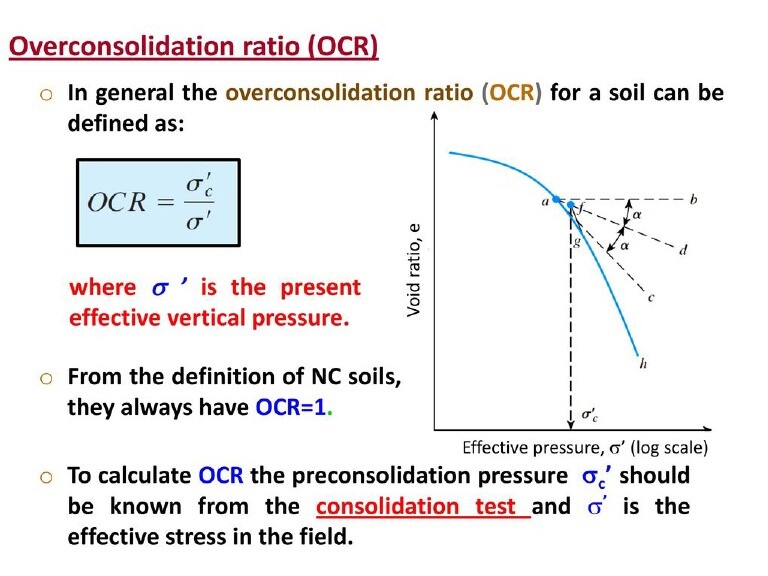When a soil sample contains a majority of particles (by weight) less than 0.063 mm in size, and stick together when wet, such soil can be described as fine-grained soil. Fine-grained soils usually contain silt and clay particles which can easily be remoulded. Silt particles are between 0.002 mm and 0.063 mm in size while clay particles are smaller than 0.002 mm.
The recommended process for establishing the engineering properties of soils is to carry out as accurately as possible, laboratory or field tests on the soil sample. The tests usually carried out on soils consist of the index properties tests, strength tests, and permeability tests.
Index property tests are usually used for the purpose of soil classification and includes particle size distribution analysis, Atterberg limits tests, linear shrinkage, specific gravity, free swell, etc. These tests are carried out on disturbed soil samples. However, strength tests can include compressibility tests (oedometer tests), shear strength tests, unconfined compression strength tests, CBR, etc. One of the most important tests is the shear strength tests which is used to obtain the angle of internal friction and cohesion of the soil.
According to BS 8004:2015, the following should be considered as minimum when establishing the values of parameters for fine-grained soils:
- the items listed in BS EN 1997-1:2004, 2.4.3(5);
- pre-existing slip surfaces;
- desscation; and
- any changes in stress state either induced by construction or resulting from the final design condition.
When the plasticity index of a clay soil is greater than 20%, it might exhibit angle of internal friction (angle of shearing resistance) that is considerably lower than that observed at the critical state, if their particles become fully aligned with one another. In BS 8004:2015, this phenomenon is called “sliding shear” in order to distinguish it from from “rolling shear” which is observed in other soils with plasticity index less than 20%. The angle of shearing resistance exhibited during sliding shear is called the “residual angle of shearing resistance“.
Estimation of Undrained Shear Strength of Fine-Grained Soils
According to clause 4.3.1.4.5 of BS 5400:2015, the undrained shear strength of a fine-grained soil may be estimated from the relationship below in the absence of reliable test data:
cu,k/p’v = k1Rok2 = k1(p’v,max/p’v)k2
Where:
cu,k = characteristic underained shear strength
p’v = effective overburden pressure
p’v,max = the maximum overburden pressure that the soil has been previously subjected to;
Ro = overconsolidation ratio
k1 and k2 are constants. In the absence of reliable test data, k1 may be taken as 0.23 ± 0.04, while k2 may be taken as 0.8. Furthermore, it should be noted that cu,k/p’v is not a constant but varies with depth.

Obviously, consolidation test results should be available before the relationship can be applied. When determining the characteristic undrained strength of high strength fine-grained soils, due allowance should be made for:
- the detrimental effect of any sand or silt partings containing free groundwater
- the influence of sampling
- the influence of the method of testing; and
- likely softening on excavation
Estimation of Constant Volume Angle of Shearing Resistance of Fine-Grained Soils
In the absence of reliable test data, the characteristic constant volume (ie the angle of internal friction at the critical state) effective angle of shearing resistance φ’cv,k may be estimated from;
φ’cv,k = (42° – 12.5log10Ip) for 5% ≤ Ip ≤ 100%
where:
Ip is the plasticity index of the soil (entered as a %)
The values of φ’cv,k for different plasticity index values based on the expression above is shown in Table 1:
| Plasticity Index Ip (%) | Characteristic constant volume angle of shearing resistance φ’cv,k (Degrees °) |
| 15 | 27 |
| 30 | 24 |
| 50 | 21 |
| 80 | 18 |
It should be noted that the effective cohesion at the critical state should be taken as zero (the characteristic constant volume effective cohesion = 0).
The peak effective angle of shearing resistance φ’pk may be related to the constant volume effective abgle of shearing resistance φ’cv by:
φ’pk = φ’cv + φ’dil
Where;
φ’cv is the constant volume effective abgle of shearing resistance
φ’dil is the contribution to φ’pk from soil dilatancy










